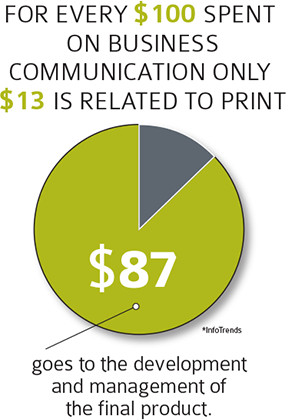What file formats and types do you accept?
We accept both print ready PDFs and native files from the most common desk top publishing programs including Mac or PC. We also accept JPG, PDF, PS, PSD, TIF and EPS files. We prefer to have both the print ready PDF and the source file.
Bleed
Bleed is when color, type or image that extends beyond the trim marks on a page. To have your color, type or image extend to the edge after trimming, we recommend extending your color, type or image beyond the final page size by 1/8". So if your final page size is 8.5" x 11"and your color, type or image is full bleed (extending beyond each of the 4 edges), the file submitted for printing needs to be 8.75" x 11.25".
What resolution do I need for photos?
Goodway uses offset printing presses using the latest in direct to plate technologies, and Xerox premier iGen4 digital presses. For both, images of 300 dpi are required to achieve sharp, bright color and image reproduction. Your images need to be saved at a resolution of 300 dpi in the final size that they will be used. Some people take images from the internet in preparing their print publication. These internet images are usually only 72dpi and will generally result in very poor print quality.
RGB vs. CMYK Color Space
To over simplify these two different color spaces-
RGB is a color space based on light. Used in digital cameras, computer monitors, digital scanners and some desktop printers.
CMYK is a color spaced based on ink. Used for commercial offset printing press projects.
RGB refers to the colors red, green and blue, which computer monitors use to display images. A four-color, offset printing press, however, prints images using a different set of colors: cyan (blue), magenta (red), yellow and black (CMYK).
Files created in RGB must be converted to CMYK before they can be printed on a four-color press. (Follow the instructions provided by your design program.) Keep in mind that files viewed in CMYK provide a more accurate representation of how your printed piece will look than what you can see in RGB mode.
Paper Options
Paper choice can make a significant difference in the look and feel of your print communication piece. Commercial printing paper is divided into two broad categories - - Coated and Uncoated (sometimes broadly referred to as offset stock). Within each of those categories are sub-categories by weight - - Text and Cover stock.
Text stock is lighter weight paper used most frequently for the inside or body of a book or catalog.
Cover stock is a heavier and more durable paper used for the outside cover of a book or catalog. The heavier the paper's weight, the more upscale the look and feel that will be achieved.
When will I receive a proof for my job?
Generally, proofs are available within 24 hours of receipt of a print-ready file.
How do I send my files?
Smaller files can be emailed as attachments, while larger files will have to be put on a portable media (disk or USB drive). Alternatively, they can be sent to us over the Internet via FTP (File Transfer Protocol). Call your sales representative to set up a private account or to receive instructions for uploading to our public folder.
Can I make changes in my file before it's printed?
Absolutely! We proof all jobs before printing either electronically via PDF or with hard proofs. Client changes can be made at this point. You can make the changes yourself and send us new files, or you can mark-up the proofs and request that we make changes to the files here.
How can I ensure quality without a press check?
We provide top quality digital proofs generated from your files. If needed, we can provide digital hard proofs or actual press proofs for few pages or one signature. The press proofs will show you sample pages on the actual paper the job will be print on. If you have any corrections, we will make them according to your instructions. No final printing is undertaken until YOU approve it. Once you approve your project for printing, we assign an experienced production coordinator to be responsible for your job through all phases of production. He or she will watch your project from beginning to end to ensure it meets our high quality standards.

